In the realm of medical device manufacturing, few products require as rigorous quality control as contraceptives. The condom testing machine has become an indispensable tool in ensuring that these critical barrier devices meet international safety standards and provide reliable protection to millions of users worldwide.
What is a Condom Testing Machine?
A condom testing machine is specialized equipment designed to evaluate the physical properties and integrity of condoms through various standardized tests. These sophisticated machines perform multiple assessments that simulate real-world conditions and stress factors, ensuring that each product batch maintains the highest quality standards before reaching consumers.
Key Testing Parameters
Modern condom testing machines evaluate several crucial aspects:
Tensile Strength Testing: This measures the force required to break a condom when stretched. The machine applies controlled tension to determine if the product can withstand normal use without tearing.
Burst Pressure and Volume Testing: Perhaps the most recognizable test, this procedure inflates condoms with air or water to measure their expansion capacity and the pressure at which they fail. International standards typically require condoms to withstand specific volumes without bursting.
Pinhole Detection: Using electrical conductivity methods, the condom testing machine can identify microscopic holes or defects that would be invisible to the naked eye but could compromise protection.
Aging Simulation: Accelerated aging tests expose condoms to elevated temperatures and humidity levels, simulating years of shelf life in compressed timeframes to ensure product stability.
Industry Standards and Compliance
Manufacturers rely on condom testing machines to comply with stringent international standards such as ISO 4074, ASTM D3492, and various national regulations. These standards mandate specific performance criteria that every production batch must meet. The automated nature of modern testing equipment ensures consistent, objective results that eliminate human error and subjective interpretation.
Technological Advancements
Contemporary condom testing machines incorporate advanced features including computer-controlled operation, automated data logging, and real-time quality monitoring. Many systems can test multiple samples simultaneously, significantly improving efficiency in high-volume production environments. Digital interfaces provide detailed statistical analysis, helping manufacturers identify trends and potential issues before they affect large quantities of product.
Impact on Public Health
The importance of reliable condom testing cannot be overstated. These devices serve as the final safeguard between manufacturing and consumer use, directly impacting sexual health outcomes globally. By ensuring consistent quality through mechanical testing, the condom testing machine plays a vital role in preventing unintended pregnancies and reducing the transmission of sexually transmitted infections.
Conclusion
As contraceptive technology continues to evolve, so too does the sophistication of quality control equipment. The condom testing machine represents the intersection of public health priorities and precision engineering, providing manufacturers with the tools necessary to deliver safe, reliable products. In an industry where failure is not an option, these machines stand as silent guardians of quality, protecting both manufacturer reputations and consumer wellbeing through rigorous, uncompromising testing protocols.








